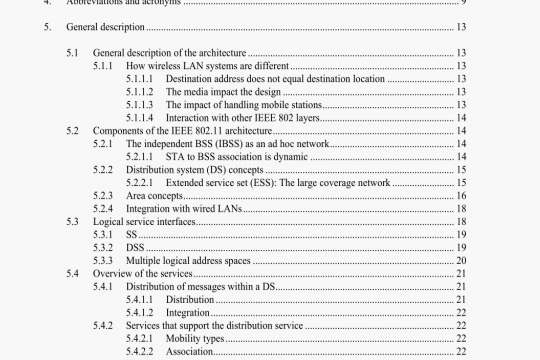ISO/IEC 8802-11 pdf download – lnformation technology — Telecommunications and informationexchange between systems – Local andmetropolitan area networks -Specificrequirements Part 11: Wireless LAN Medium Access Control(MAC) and Physical Layer (PHY) specifications.
14.1 Overview
14.1.1 Overview of FHSS PHY
The PItY scrsices proisded to thc IEEE KO2.1 I wireless LAN MAC fur the 2.4 GIlt frequency-hopping spread spectnnn tIHSS) system are described in this cbuse The HISS PHY consists of the following two protocol functions:
a) A PHY comcrgence function, which adapts the capabilities of the PMD system to the PHY service. This function is supported by the PLC’P. which defines a method of mapping the IEEE 802.11 MPDUs into a flaming format suitable fur sending and receising user data and management infornution between two or Inure STAs using the associated Ps1D system.
bi A PMD system, whose funcuon defines the characteristics of, and method of tnuismllting and receiving data through, a WM between two or mote STAs.
14.1.2 FHSS PHY functions
The 2.4 GIlt FuSS PIIY architecture is shown in Figure II (in 5.8). The HISS PIIY contains three functional entities: the PMD function, the PHY consergence function, and the P1W management function. Each of these functions isdescribed indelail in 14.1.2.1 through 14.1,2,3.
The FHSS PHY set’s ice is pros ided to the MAC entity at the STA through a SAP, called the PHY-SAP. as shown in Figwe II. A set of primitives might also be defined that dcscnbc [he interface between the PLCP subbyc, and the PMD sublayer, called the PMD_SAP.
14.1.2.1 PLCP sublayer
To allow the IEEE. 802.11 MAC to operate with minimum dependence on the PML) sublayer, a PHY convergence sublayer is defined. This function simplifies pros ision of a PHY scnicc interface to the IEEE 802.11 MAC services.
14.1.2.2 PLME
The PLME performs management of the local PHY functions in conjunction with the MLME.
14.1.2.3 PMD sublayer
The PM[) sublayer pinvides a transmission interface used to send and receive data between Iwo or more STAs.
14.1.3 Service specification method and notation
The models represented by state diagrams in the following subclauses are intended as the primary specifics. tions of the functions prosidcd It is important to distinguish, however, between a model and a real implensentation, The models are optimized for simplicity and clarity of presentation, while any realistic implementation may place heavier cmplsssis on efficiency and suitability to a particular implementation technology.
The service of a lava or aublayer is the set of capabilities that it offers to a user in the next higher layer (or aublayer). Abstract services arc specified here by desenbeng the scnicc primitises and parameters that characterize each senice. This defininon of service is independent of any particular implementation.
14.2 FHSS PHY-specific service parameter lists
14.2.1 OvervIew
The architectire of the IEEE X02. II MAC is intended to be PItY independent, Some PItY implementations require medium management state machines miming in the MAC sublayer m order to meet certain PMD requirements These PIIY-dependent MAC slate machines reside in a sublayer defined ar the MLME. The MLMF in certain PM[) implementations may need to interact with the P[ME as part of the normal PItY-SAP primitises These interactions ate defined by the PLMF parameter list currently defined in the PItY Sen ice Primitives as TX VECTOR and RXVECTOR The hst of these parameters and the salues they may represent are defined in the specific P1W specifications for each PMD, This subclause addresses the TXVECTOR and RXVRTOR for the 11155 PItY.
All of the values included in the TX VECTOR or RXVECTOR described in this suhelause are considered mandatory unless otherwise specified. The I MbiLa and 2 Mhit’s data rates arc the only rates currently supported. Other indicated data rates are for possible future use.
14.2.2 TXVECTOR parameters
The parameters in Table 31 are defined as part of the TXVETOR parameter list in the PItYTXSTART.requcst service primitise.
ISO/IEC 8802-11 pdf download – lnformation technology — Telecommunications and informationexchange between systems – Local andmetropolitan area networks -Specificrequirements Part 11: Wireless LAN Medium Access Control(MAC) and Physical Layer (PHY) specifications
